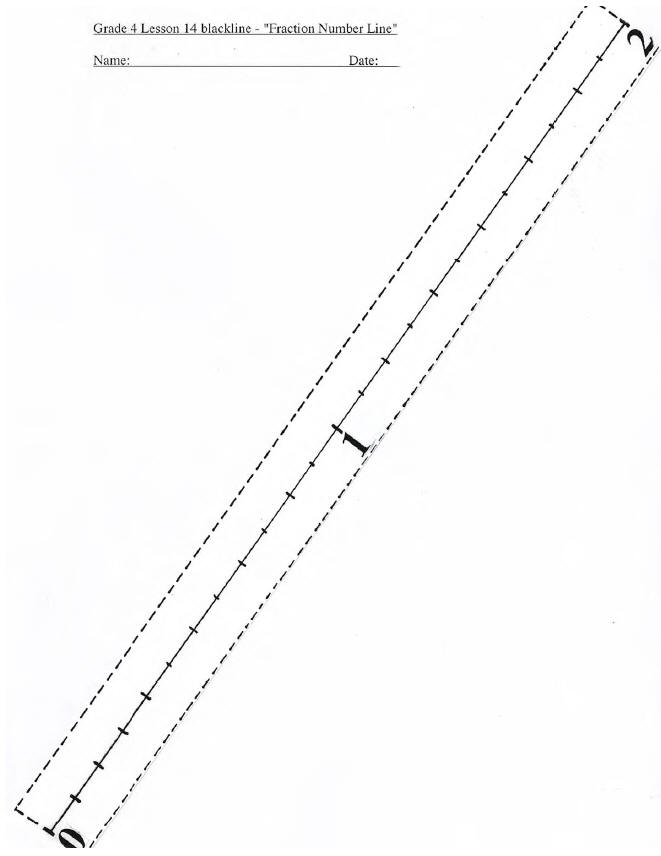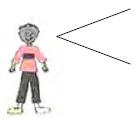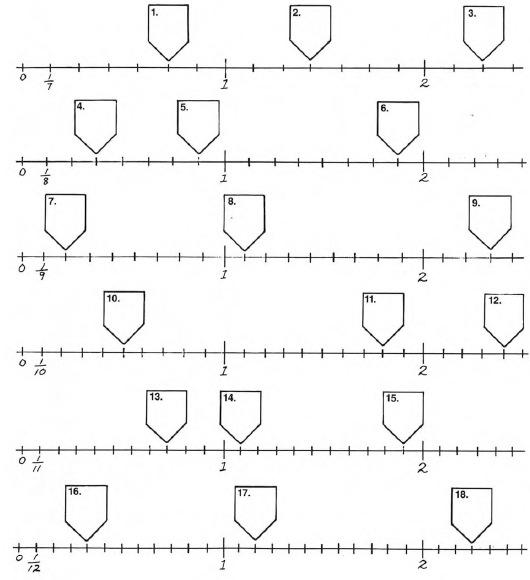Number Lines and Mixed Numbers
Purpose:
To form the beginning of a number line with fractions
Materials:
Fraction Bars, Transparent bars, Transparent Number Line (Transparency Kit),
Master "Fraction Number Line", pencils, markers
TEACHER MODELING/STUDENT COMMUNICATION
| Fraction Bars and pencils Masters Transp Transp |
Activity 1 Forming a number line from 0 to 1
with fractions 1. Each group will need a
deck of bars and each student will need a pencil and a Master |

 What fraction
should we write below the line for this bar and where should it be
What fraction
should we write below the line for this bar and where should it be
written? (2/12 should be placed beneath the mark at the end of the shaded
part of
the bar.)
 Write this fraction on your number
line.
Write this fraction on your number
line.
 Select a different orange bar that is
not a zero bar or a whole bar and place it on
Select a different orange bar that is
not a zero bar or a whole bar and place it on
your line between 0 and 1. Write the fraction on your line at the end of the
shaded part of your bar. Ask a volunteer to describe the bar they selected.
Place
a transparent copy of their bar on the overhead and write its fraction on the
line.
Ask students to write all the fractions for the remaining
marks between 0 and 1 on their
number line. Then place the transparent orange whole bar below the line and
between 0
and 1 and ask:
 Why is the number 1 written for the
whole bar? (Because the fraction for a
Why is the number 1 written for the
whole bar? (Because the fraction for a
whole bar equals one.) Leave this whole bar below the number line for the next
activity.
| same materials |
Activity 2 Extending the line to the length of
two whole bars Place the transparent orange 2/12 bar between 1 and 2 (see next page) and ask: |

 What number
should be written below the 2/12 bar? (
What number
should be written below the 2/12 bar? ( )
Write this number
)
Write this number
on the transparent line and ask students to write it on their lines.
 The "1" in this number is for the 1
whole bar and 2/12 is for the shaded
The "1" in this number is for the 1
whole bar and 2/12 is for the shaded
amount of the next bar. We call this number "1 and 2/12".
 This type of number is a mixture of two
types of numbers: the whole number
This type of number is a mixture of two
types of numbers: the whole number
1 and the fraction 2/12. It is called a "mixed number." We can also write 1
and 2/12 as the sum 1 + 2/12.
 Select a different orange bar that is
not a zero bar or a whole bar, place it on
Select a different orange bar that is
not a zero bar or a whole bar, place it on
your line between 1 and 2 and write the mixed number for the bar. Ask a few
students to describe their bar and give its mixed number. As they do, point to
the marks on the transparent line.
 To avoid crowding on your number line
between 1 and 2, we will just write
To avoid crowding on your number line
between 1 and 2, we will just write
the mixed numbers: 1 and 2/12; 1 and 4/12; 1 and 6/12; 1 and 8/12; and 1 and
10/12. Point to these marks on the transparent number line and write these
mixed numbers.
 Why is the number 2 written on the
number line? (It is at the end of the
Why is the number 2 written on the
number line? (It is at the end of the
second bar and represents a length of 2 whole bars.)
| markers
Fraction completed Fraction |
Game: Number Lines Race The Fraction Number Lines and markers will be needed to play a racing game.
Discuss this game and any questions. Ask each
student to write their names on the Option: Use the deck of Fraction Playing Cards for the Number Line Race. |
INDEPENDENT PRACTICE and ASSESSMENT
Activity Sheet #14A Writing fractions and mixed numbers
for points on number lines
Activity Sheet #14B Writing fractions and mixed numbers for points on number
lines
fractionbars.com Set 2 Fraction Darts (Using mixed numbers to aim darts at
balloons)

Grade 4 Activity Sheet #14A Name:
| The first number line below is the number line you formed in class using the twelfths bars, but it has some missing numbers.
|
 |
1. Write the missing fractions and mixed numbers on the
line in the markers.

2. This number line was made using the twelfths bars, but
it has the fractions for
halves and thirds that equal the fractions for twelfths. Write the missing
numerators in
the markers.

3. This number line was made using the twelfths bars, but
it has the fractions for
halves and fourths that equal the fractions for twelfths. Write the missing
numerators
in the markers.

4. Here is part of the twelfths number line from 2 to 4.
Write the missing mixed numbers for
this line on the markers.

Grade 4 Activity Sheet #14B Name:
 |
For each line, write a fraction or mixed number on the marker for the given point. Notice that the first point beyond zero is numbered for each line.
|

 What
do you notice about your number line? (It has the numbers 0, 1, and
2. It
What
do you notice about your number line? (It has the numbers 0, 1, and
2. It Which color of your bars is divided
into 12 equal parts? (orange bars)
Which color of your bars is divided
into 12 equal parts? (orange bars) You can think of this line between
0 and 1 as a very skinny bar with 12 equal
You can think of this line between
0 and 1 as a very skinny bar with 12 equal Place one marker above the zero
point on your number line.
Place one marker above the zero
point on your number line. The bars should be spread out face
down.
The bars should be spread out face
down. Each player in turn takes a bar
and the shaded amount tells how far this player's
Each player in turn takes a bar
and the shaded amount tells how far this player's The first player to reach the
number "2" or go beyond is the winner.
The first player to reach the
number "2" or go beyond is the winner.
